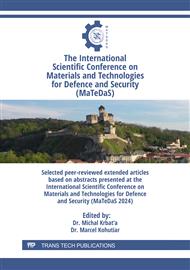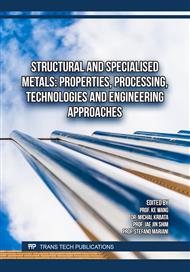[1]
S. Wang, T. Zhang, W. Deng, S. Zhanwen, S. To, Analytical modeling and prediction of cutting forces in orthogonal turning: a review, The International Journal of Advanced Manufacturing Technology 119 (2022) 1407–1434.
DOI: 10.1007/s00170-021-08114-y
Google Scholar
[2]
I. M. Petre, C. Găvruş, Influence of the cutting force upon machining process efficiency, 72/2, (2023), 586-593.
DOI: 10.1016/j.matpr.2022.10.063
Google Scholar
[3]
D. Handayani, V. F. Okhuysen, N. Wagner, Machinability of High Mn Steel Using Tool Life Criteria, International Journal of Metalcasting 18 (2023) 600-607.
DOI: 10.1007/s40962-023-01044-3
Google Scholar
[4]
T. Kıvak, G. Uzun, E. Ekici, An Experimental and Statistical Evaluation of The Cutting Parameters on The Machinability of Hadfield Steel, Materials Science, Engineering, (2016).
Google Scholar
[5]
J. Shinozuka et al., Effecto of MnS on the cutting mechanism of powder metallurgy steel in cutting speeds ranging from 1 m/s to 150 m/s, Advanced Materials Research (2012).
DOI: 10.4028/www.scientific.net/amr.565.370
Google Scholar
[6]
A. Erden et al., Investigation of microstructure, mechanical and machinability properties of Mo-added steel produced by powder metallurgy method, The International Journalo of Advanced Manufacturing Technology (2021).
DOI: 10.1007/s00170-021-07052-z
Google Scholar
[7]
P. Kovač, T. et al., Modelling of Cutting Forces in Hard Steel Turning, Springer, 128 (2020), pp.208-220.
Google Scholar
[8]
M. Boy, N. Yasar, I. Ciftci: Experimental investigation and modelling of surface roughness and resultant cutting force in hard turning of AISI H13 Steel, Conf. Series: Materials Science and Engineering, 161 (2016).
DOI: 10.1088/1757-899x/161/1/012039
Google Scholar
[9]
V. Sivaramana, S. Sankaranb, L. Vijayaraghavan, The Effect of Cutting Parameters on Cutting Force During Turning Multiphase Microalloyed Steel, 3rd CIRP Conference on Process Machine Interactions (3rd PMI) (2012) 157-160.
DOI: 10.1016/j.procir.2012.10.028
Google Scholar
[10]
K. Zhuang, Jinqiang Gao, Tao Ye, Xing Dai, Effect of cutting edge radius on cutting force and surface roughness in machining of Ti-6Al-4V, 6th CIRP Conference on Surface Integrity, Procedia CIRP 108 (2022) 571–576.
DOI: 10.1016/j.procir.2022.03.090
Google Scholar
[11]
R. Nur, N. M.Yusof, I. Sudin, F. M. Nor, D. Kurniawan, Determination of Energy Consumption during Turning of Hardened Stainless Steel Using Resultant Cutting Force, Metals MDPI, Vol. 11 (2021), p.565.
DOI: 10.3390/met11040565
Google Scholar
[12]
J. Majerík, J. Majerský, H. Chochlíková, I. Barényi, J. Escherová, M. Kubasáková, Machining of M390 Microclean® and M398 Mircoclean® PM Steels – The Comparison of Cutting Forces and Surface Roughness, Manufacturing Technology, 23/6 (2023).
DOI: 10.21062/mft.2023.096
Google Scholar
[13]
CH. R Sohar, Lifetime Controlling Defects in Tool Steels, Institute of Chemical Technologies and Analytics Vienna University of Technology Getreidemarkt, Springer Heidelberg Dordrecht London New York, (2011) ISBN 978-3-642-21645-9.
Google Scholar
[14]
BOHDAN BOLZANO Materiálový list ocele ASP2017. Available online: https://bolzano.sk/wp-content/uploads/2020/01/ASP2017.pdf
Google Scholar
[15]
BOHDAN BOLZANO Materiálový list ocele ASP2055. Available online: https://bolzano.sk/wp-content/uploads/2020/01/ASP2055.pdf
Google Scholar
[16]
BOGNER EDELSTAHL Materiálový list ocele X153CrMoV12. Available online: https://www.bogner.cz/files/lists/1-2379.pdf
Google Scholar
[17]
VOESTALPINE BÖHLER EDELSTAHL GMBH & CO-KG. 2019. M390 Microclean® Plastic mould steel. Kapfenberg, In voestalpine Böhler Edelstahl GmbH & Co-KG. 2019. 16 s. M390 EN - 01.2019.
DOI: 10.1007/s10765-020-02765-x
Google Scholar
[18]
VOESTALPINE BÖHLER EDELSTAHL GMBH & CO-KG. 2018. M398 Microclean® Plastic mould steel., Kapfenberg. In voestalpine Böhler Edelstahl GmbH & Co-KG. 2018. 16 s. M398 EN - 10.2018.
DOI: 10.1007/s10765-020-02765-x
Google Scholar



